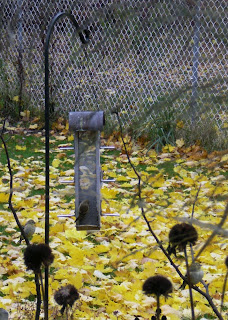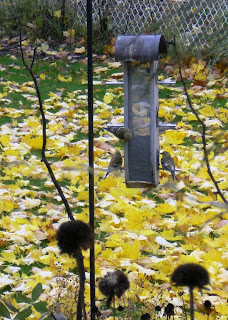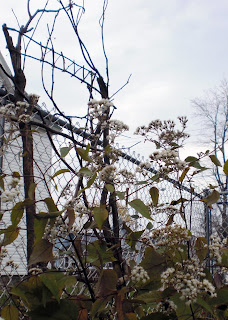Where do I get them from (since you might know from past posts that I don't have any mature trees on my lot)? People here put them out on the curb after pruning or cleaning up their yards for the village to pick up - unless I get there first. Sometimes they put out nice pine and evergreen boughs, too, that look lovely in the window boxes and baskets over the winter. I also can find whatever size branches I need at the local dump free for the taking. Big piles of all sorts.
What do I do with them? Well, I noticed that the birds tend to "line up" for the feeders and bird baths and would land on my flowers and bend them down to the ground. So, I stuck a few branches nearby for them to use as perches instead - this worked like a charm! Here's a "branch perch" over a bird bath ...
Above is a Gold Finch perched upon it. Below is a Gold Finch poised on a "branch perch" (lower left corner above the big Monarda seed head) angling for a spot on the bird feeder ...
There he goes!
I also use branches to make my own rustic trellises. All you need is a power drill, some screws, hammer, nails, and maybe a little wire for the smaller branches. Here's one in the kitchen garden ...
And here's one I made for a wild rose that I will train to climb (and that will hopefully spill over and cover up some of that ugly chain link fence - ugh!) It adds a little more height and should act as a privacy screen ...And here's one I made for this beautiful honey suckle to reach the lattice work on the front porch ...
You can also use branches and seed heads (like Black Eye Susan, Bee Balm and Cone Flowers) to dress up your pumpkins on Halloween. Branches make nice "hair." I just use a screw driver to punch holes with. Or you can make gourd ghouls like these ...Happy Halloween!



















































